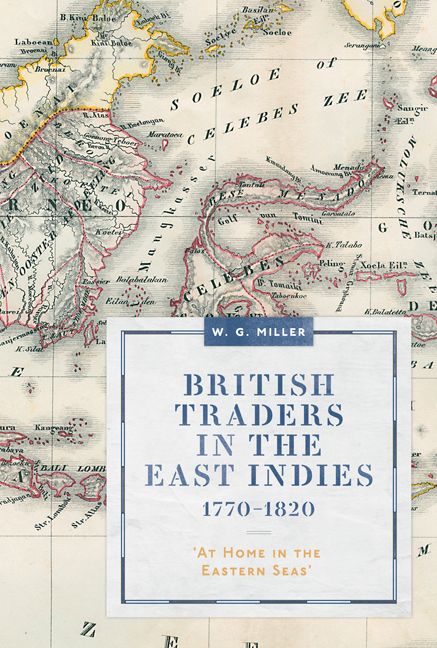Book contents
- Frontmatter
- Dedication
- Contents
- List of illustrations
- Preface
- Acknowledgements
- A note on orthography and unit conversion
- Abbreviations
- Map
- Introduction: the Indian origins of the British country trade
- Chapter One Merchant friends: country traders and the Malays I
- Chapter Two Political allies: country traders and the Malays II
- Chapter Three Inadvertent imperialists: country traders and British officials
- Chapter Four Smugglers and enemies: country traders and the Dutch
- Chapter Five The decline of the country trade in the Malay Archipelago
- Conclusion
- A note on sources
- Bibliography
- Index
- WORLDS OF THE EAST INDIA COMPANY
Chapter Five - The decline of the country trade in the Malay Archipelago
Published online by Cambridge University Press: 16 September 2020
- Frontmatter
- Dedication
- Contents
- List of illustrations
- Preface
- Acknowledgements
- A note on orthography and unit conversion
- Abbreviations
- Map
- Introduction: the Indian origins of the British country trade
- Chapter One Merchant friends: country traders and the Malays I
- Chapter Two Political allies: country traders and the Malays II
- Chapter Three Inadvertent imperialists: country traders and British officials
- Chapter Four Smugglers and enemies: country traders and the Dutch
- Chapter Five The decline of the country trade in the Malay Archipelago
- Conclusion
- A note on sources
- Bibliography
- Index
- WORLDS OF THE EAST INDIA COMPANY
Summary
By 1820 the British country traders who had operated successfully for over fifty years in the Malay Archipelago faced a changing world. While private vessels continued to sail to Canton and were still referred to as “country traders”, the nature of the maritime trade within the Malay Archipelago was changing dramatically.
Locally, the most important factor to bring about this change was the establishment and immediate success of the trading entrepôt of Singapore in 1819. With Singapore, the pattern of the local, or “native” trade within the Malay Archipelago altered in a way that Raffles had foreseen. He knew that the “native authorities” of the archipelago would “hail with satisfaction the foundation and the site of a British establishment, in the central and commanding situation”. It would not only improve relations with British “merchants” as he had foretold, but change the whole pattern of the trade undertaken by country traders.
In Singapore, from an original population made up of mainly indigenous groups with only a few dozen Malays and Chinese, the Chinese, Malay and Indian communities quickly expanded. In 1824, there were still only 74 resident Europeans.
Singapore began to replace Riau, the focal trading port for country traders which had been largely destroyed by the Dutch in 1784. Towards the end of 1819, a group of Bugis amounting to 500 people relocated from Riau to Singapore in a block, and by 1824 there were 1,925 Bugis there, “all traders, not agriculturalists”. The trade through Riau, and Malacca, correspondingly fell. With this changed pattern, the trade was coming to Singapore; there was less need for the country traders to go to the native ports. In two-and-a-half years from 1819 to 1821, of the 2,889 vessels that entered Singapore, only 383, or 13.2%, were manned by Europeans. While admittedly smaller craft, the remaining 2,506 were manned by natives of other nations. In 1822 the percentage of European vessels, at 8.8%, was even lower.
Horsburgh would be proved correct when he wrote in 1819 that “The Bugguese prows from Celebes and other parts of the Eastern Islands will resort to the settlement of Singapore with their goods, and barter them for our manufactures, in preference to going to Malacca or Batavia, and it will soon become a depot for the Eastern traders”.
- Type
- Chapter
- Information
- British Traders in the East Indies, 1770–1820'At Home in the Eastern Seas', pp. 177 - 184Publisher: Boydell & BrewerPrint publication year: 2020



